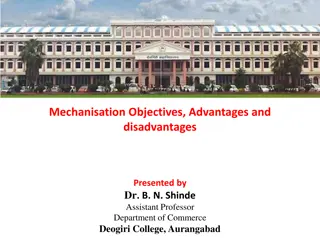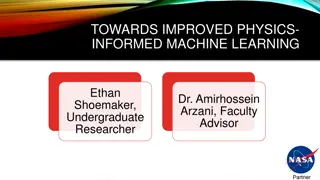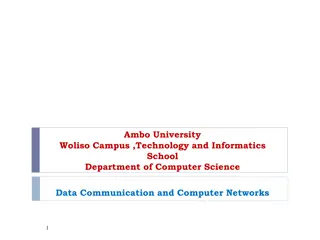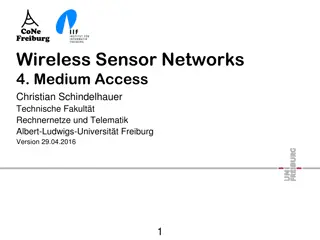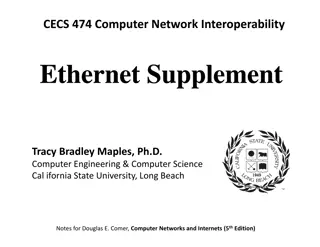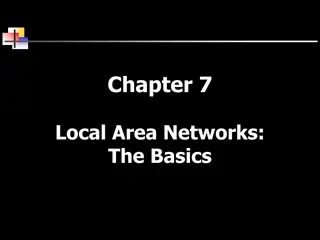Understanding Computer Networks: Advantages, Disadvantages, and Components
Explore the world of computer networks with this comprehensive guide covering the definition, benefits, drawbacks, and key components of networking systems. Discover how computer networks facilitate communication, resource sharing, and flexibility while also facing challenges such as security risks and maintenance requirements.
Download Presentation

Please find below an Image/Link to download the presentation.
The content on the website is provided AS IS for your information and personal use only. It may not be sold, licensed, or shared on other websites without obtaining consent from the author. Download presentation by click this link. If you encounter any issues during the download, it is possible that the publisher has removed the file from their server.
E N D
Presentation Transcript
CHAPTER - XI COMPUTER NETWORKS I
Class XII Unit I Programming and Computational Thinking (PCT-2) (80 Theory + 70 Practical) Prepared by Praveen M Jigajinni DCSc & Engg, PGDCA,ADCA,MCA.MSc(IT),Phd(biology),MBBS,Mtech(IT),MPhil (Comp. Sci) Department of Computer Science, Sainik School Amaravathinagar Cell No: 9431453730
INTRODUCTION What is Computer Network? A computer network is a set of computers connected together for the purpose of sharing resources. The most common resource shared today is connection to the Internet. Other shared resources can include a printer The Internet itself can be considered a computer network or a file server.
ADVANTAGES OF COMPUTER NETWORK 1. IT ENHANCES COMMUNICATION AND AVAILABILITY OF INFORMATION. 2. IT ALLOWS FOR MORE CONVENIENT RESOURCE SHARING. 3. IT MAKES FILE SHARING EASIER.
ADVANTAGES OF COMPUTER NETWORK 4. IT IS HIGHLY FLEXIBLE. 5. IT IS AN INEXPENSIVE SYSTEM. 6. IT BOOSTS STORAGE CAPACITY.
DISADVANTAGES OF COMPUTER NETWORK 1. IT LACKS INDEPENDENCE. 2. IT POSES SECURITY DIFFICULTIES. 3. IT LACKS ROBUSTNESS.
DISADVANTAGES OF COMPUTER NETWORK 4. IT ALLOWS FOR MORE PRESENCE OF COMPUTER VIRUSES AND MALWARE. 5. IT REQUIRES AN EFFICIENT HANDLER. 6. IT REQUIRES AN EXPENSIVE SET-UP.
COMPONENTS OF COMPUTER NETWORK 1. HUBS 2. SERVERS 3. CLIENT 4. COMMUNICATION CHANNEL
COMPONENTS OF COMPUTER NETWORK 1. HUBS
COMPONENTS OF COMPUTER NETWORK 1. HUBS A network host is a computer or other device connected to a computer network. A network host may offer information resources, services, and applications other nodes on the network. There are two types of hub: (I) ACTIVE HUB (II) PASSIVE HUB to users or
(I) ACTIVE HUB (i) it s electrically amplify the signal as it moves from one connected device to another. (ii)active concentrators are used like repeaters to extend the length of the network.
REPEATERS: it s an device that electrically amplifies the signal it receives and rebroadcasts it.
(ii) PASSIVE HUB computer to another without any change. It allows the signal to pass from one
COMPONENTS OF COMPUTER NETWORK 2. SERVERS
COMPONENTS OF COMPUTER NETWORK 2. SERVERS A server is a type of computer or device on a network that manages network resources. Servers are often dedicated.
COMPONENTS OF COMPUTER NETWORK 3. CLIENT(S)
COMPONENTS OF COMPUTER NETWORK 3. CLIENT A client is a piece of computer hardware or software that accesses a service made available by a server.
COMPONENTS OF COMPUTER NETWORK 4. COMMUNICATION CHANNEL
COMPONENTS OF COMPUTER NETWORK 4. COMMUNICATION CHANNEL A communication channel or simply channel refers either to a physical transmission medium such as a wire, or to a logical connection over a multiplexed medium such as a radio channel in telecommunications and computer networking
COMPONENTS OF COMPUTER NETWORK 4. COMMUNICATION CHANNEL Types of communication channels are: 1. WIRED OR GUIDED COMMUNICATION CHANNEL 2. WIRELESS OR UNGUIDED COMMUNICATION CHANNEL
4. COMMUNICATION CHANNEL 1. WIRED OR GUIDED COMMUNICATION CHANNEL
1. WIRED OR GUIDED COMMUNICATION CHANNEL through guided media Like ,network cables like it s called wired communication channels/medium Example: TWISTED-PAIR CABLES COAXIAL CABLES FIBRE OPTICAL CABLE . When host and server with one another
4. COMMUNICATION CHANNEL 2. WIRELESS OR UNGUIDED COMMUNICATION CHANNEL
2. WIRELESS OR UNGUIDED COMMUNICATION CHANNEL with one another through guided media. Like, radio waves ,satellite etc., When hosts and server are connected Example of wireless communication: RADIO WAVE , MICRO WAVE, SATELLITE etc.,
TYPES OF NETWORK network Computers A network can mean a small of linked computers to a chain of a few hundred computer of different types (eg , PCs, minis, mainframes etc ) Spread around the world. A computer network means a group of
TYPES OF NETWORK BASED ON GEOGRAPHICAL SPREAD spread , network can be divided into two types: Based on network span or geographical (I)LAN (LOCAL AREA NETWORK) (II)WAN(WIDE AREA NETWORK)
TYPES OF NETWORK BASED ON GEOGRAPHICAL SPREAD LAN(LOCAL AREA NETWORK)
LAN (LOCAL AREA NETWORK) Small computer network that are confined to a localised are a ( eg ; an office , a building or a factory) are known as LAN s. The key purpose of LAN is to serve its users in resource sharing . The hardware as well as software resources are shared through LAN s. LAN users can share data , information , programs , printers , modems ,etc.,
TYPES OF NETWORK BASED ON GEOGRAPHICAL SPREAD WAN (WIDE AREA NETWORK)
WAN (WIDE AREA NETWORK) The network spread across countries (or) on a very big geographical area are known as WAN s. It is a group of computers that are separated by a large distance and tied together . It can be a group of LAN s that are separated across several locations and connected together to look like one big LAN. Computers are connected to a wide area network are often connected through public networks such as telephone systems .
LAN WAN LAN WAN
DIFFERENCE BETWEEN LAN & WAN S.NO LAN WAN IT IS SPRED OVER A SMALL AREA IT IS SPREAD OVER A VERY LARGE AREA 1) IT IS USUALLY COSTS LESS TO SET IT UP IT IS USUALLY A SINGLE NETWORK IT COSTS HIGHER TO SET IT UP 2) IT IS USUALLY A NETWORK OF MANY NETWORK 3)
TYPES OF NETWORK BY COMPONENTS can classify networks is the role played by network computers operations on basis , there are 2 types of networks: Another parameter based on which you in the network (I) PEER TO PEER NETWORKS II) CLIENT / SERVER NETWORKS
TYPES OF NETWORK BY COMPONENTS PEER TO PEER (P2P) NETWORKS
PEER TO PEER (P2P) NETWORKS meaning word Peer (ex : Each computer on P2P network is equal) , that is each computer can play a role of a client or a server. The computer that serve on P2P computers are often termed as non- dedicated servers Contd . P2P network literally implements the
PEER TO PEER (P2P) NETWORKS (P2P) networks are popular as home networks and for use in small companies as they are inexpensive and easy to install ,but they are limited scope and are difficult to secure. On small networks , workstation that can double up as a server is known as NON-DEDICATDED SERVER . Non Dedicated Server can shuttle b\w client as well as server role. Small networks that are using such a servers are known as P2P networks.
TYPES OF NETWORK BY COMPONENTS CLIENT / SERVER NETWORKS
CLIENT / SERVER NETWORKS Unlike P2P networks , bigger networks prefer to have centralised control . They do this by clearing designations servers and clients such networks are called CLIENT-SERVER NETWORKS (or) MASTER-SLAVE NETWORKS. On bigger network installation , there is a computer reserved for the server s job and its only job is to help workstations access the data, software , hardware resources . CONTD
CLIENT / SERVER NETWORKS It does not double up as workstation and such servers is known as dedicated servers. Dedicated servers operates solely as a server on a network. For ex : There may be a server exclusively for serving files related requests like storing files deciding about their access privileges & regulating the amount of space allowed for each server.
DIFFERENCE BETWEEN CLIENT SERVER AND P2P SERVICE CLIENT SERVER P2P SECURITY The server controls security of network MANAGE MENT the network . Needs a dedicated team of people to manage the server . No central control over security No central control over the network . Any one can set up. The server manages







